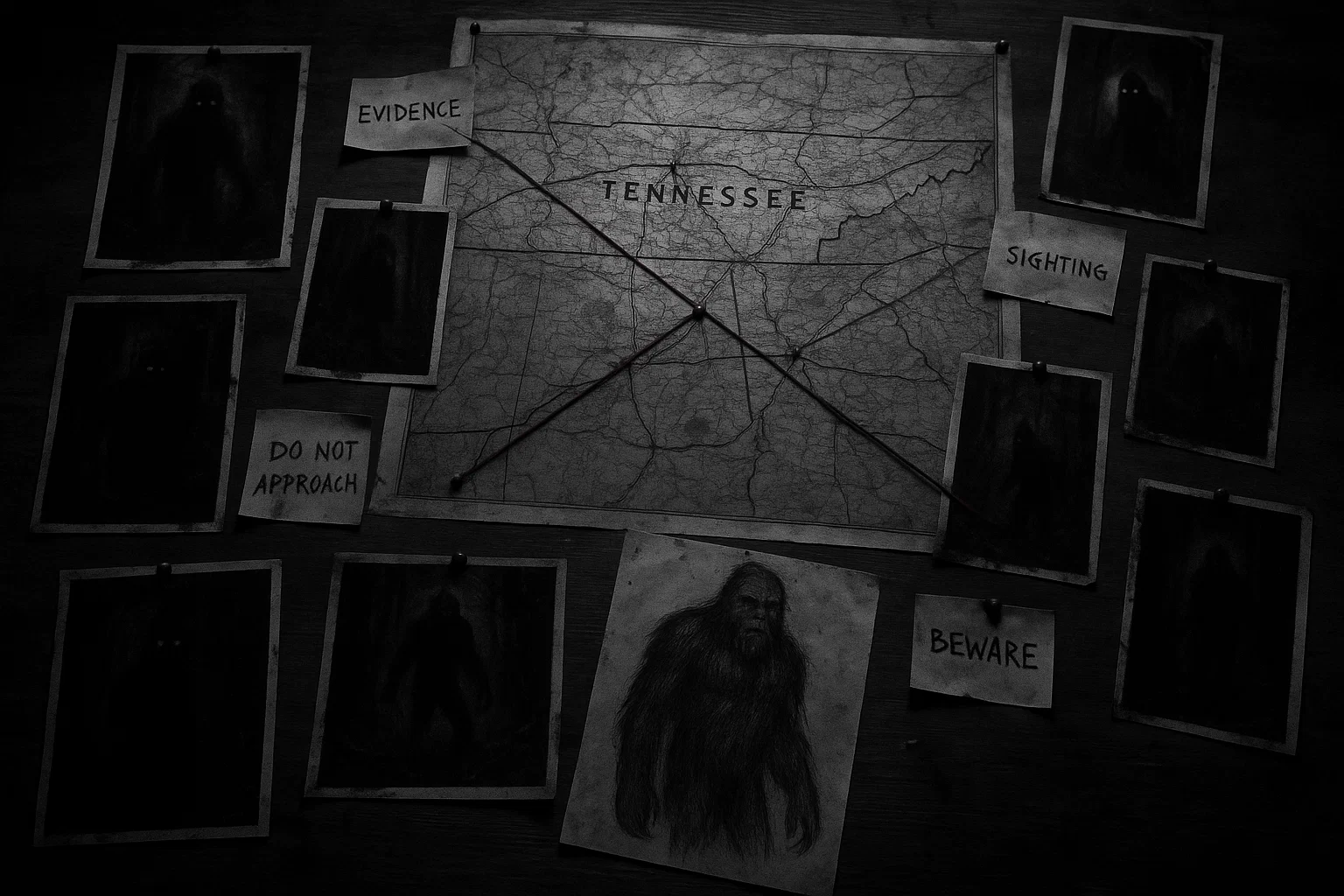Deep in the heart of Tennessee, where rolling hills meet dense forests, Tennessee Bigfoot sightings have woven a tapestry of mystery and intrigue. From the misty peaks of the Appalachian Mountains to the shadowy depths of the Cumberland Plateau, the Volunteer State has become a beacon for those captivated by the legend of Bigfoot, a towering, hairy creature said to roam its wilderness.
With over 100 documented encounters, Bigfoot sightings in Tennessee spark curiosity among locals, researchers, and skeptics, offering tales of fleeting glimpses, eerie howls, and unexplained footprints.
This article delves into the rich history of these sightings, exploring detailed accounts, rigorous investigations, and the broader context of Tennessee’s cryptid lore, inviting readers to ponder what might lurk in the state’s untamed landscapes.
Summary
Tennessee Bigfoot Sightings
Tennessee’s diverse terrain, from the sprawling Great Smoky Mountains National Park to the secluded hollows of Middle Tennessee, creates an ideal habitat for the elusive Sasquatch. According to the Bigfoot Field Researchers Organization (BFRO), Tennessee ranks among the top states for credible Bigfoot sightings, with over 100 reports cataloged since the 1970s.
These encounters describe a creature standing 7–9 feet tall, covered in shaggy fur, often emitting a foul, skunk-like odor, and leaving behind massive footprints or eerie vocalizations. Tennessee Bigfoot sightings span urban fringes to remote wilderness, with hotspots in counties like Sevier, Lincoln, and Cannon, fueling local folklore and national fascination.
The following table compiles notable Tennessee Bigfoot sightings, drawn from credible reports, primarily from the BFRO database and other regional sources. It includes verified incidents from the earliest documented cases to 2025, organized chronologically by year, with specific details on date, witness, location, and description:
| Date | Witness | Location | Description |
|---|---|---|---|
| April 13, 1871 | Unknown | McNairy County, near Piney | A 7-foot-tall creature with fiery red eyes, long matted hair, and a beard reaching its waist was seen. It approached women with wild screams, fleeing from men with remarkable speed, leaping fences effortlessly. |
| 1974 | Unknown | Williamson County | A large, hairy, bipedal creature was spotted in a wooded area, moving swiftly through dense brush. The witness reported a strong, unpleasant odor and heard deep, guttural vocalizations. |
| 1976 | Jennie Robertson | Flintville, Lincoln County | A 7–8-foot-tall creature, dubbed the Flintville Monster, chased Robertson’s son in a field. It had dark fur, a skunk-like smell, and left 16-inch footprints. Other residents reported it attacking cars and homes. |
| 1979 | Unknown | Duck River, near Columbia, Maury County | Two hikers encountered a 7–8-foot creature with a human-like yet ape-like face. It emitted a loud, growling scream and fled, leaving a small tree twisted and broken at 6 feet high. |
| November 6, 1992 | Darrell Denton | Cannon County, near grandfather’s home | Denton, former mayor of Ridgetop, saw an 8-foot-tall creature with black fur, black eyes, and gritted teeth across a field. It roared loudly, echoing through the woods, causing intense fear. |
| 1992 | Unknown | Cumberland County, near Crossville | A father and son camping heard a large creature approach their campsite at night. It was silhouetted against the moonlight, and when the father fired a shotgun, the creature seemed unfazed and fled. |
| 2001 | Unknown | Carter County, near Elizabethton | A hiker reported a 7-foot creature with dark brown fur watching from a ridge. It made no sound but left large, human-like footprints in soft soil near a creek. |
| 2011 | Unknown family | Clingmans Dome, Great Smoky Mountains National Park | A family captured video of a large, hairy, bipedal creature moving through the forest. It had dark fur, broad shoulders, and a human-like gait, vanishing after noticing the family. |
| June 2021 | Unknown | Lawrence County | A motorist reported a tall, hairy figure crossing a rural road at dusk. It moved quickly into the woods, leaving behind a faint trail of disturbed vegetation and a lingering odor. |
| 2023 | David Golden | Flintville, near Teal Hollow Road | Golden and his brother saw a white, albino-like figure in the hills, described as large and fleeting. Local reports noted nighttime screams distinct from bobcats or coyotes. |
Notes: While the BFRO notes over 100 reports, many lack precise witness names or exact dates, often due to anonymity requests or incomplete documentation. Counties like Sevier, home to the Smokies, and Lincoln, with its Flintville legends, consistently report activity, suggesting these areas are prime Bigfoot habitats. The consistency of descriptions—tall, hairy, bipedal creatures with foul odors or eerie cries—lends weight to the phenomenon, though skeptics point to potential misidentifications of bears or hoaxes.
You May Also Like: Complete Guide to Pennsylvania Bigfoot Sightings (1972–2025)
Investigation Efforts in Tennessee
Investigating Tennessee Bigfoot sightings is a multifaceted endeavor, blending grassroots enthusiasm with systematic research. The Bigfoot Field Researchers Organization (BFRO) leads these efforts, maintaining a detailed database and conducting expeditions in hotspots like the Great Smoky Mountains and Cumberland Plateau.
BFRO investigators, including founder Matt Moneymaker, prioritize firsthand accounts from credible witnesses, such as adults with no prior Bigfoot interest, and have documented over 100 cases in Tennessee since the 1990s. Their methods include nighttime surveillance, wood knocks (striking trees to elicit responses), and analyzing physical evidence like footprints or hair samples.
Beyond the BFRO, Fortean TN, founded in 2015, is a prominent local group exploring Tennessee’s cryptid and paranormal phenomena. Led by researchers like Randy Hutchings, Fortean TN has interviewed nearly 200 Bigfoot witnesses and conducted field investigations in rural areas, including the Cumberland Plateau and Land Between the Lakes.
Their expeditions often involve enthusiasts, with nearly 100 participants joining outings to experience phenomena firsthand. Fortean TN also investigates related mysteries, such as UFO sightings and hauntings, suggesting a holistic approach to Tennessee’s unexplained events.
East Tennessee Bigfoot, another local organization, focuses on the Appalachian region, particularly Sevier and Carter counties. Led by Matt Seeber, this group collects witness testimonies and investigates reports of vocalizations, stick structures, and tracks. Their work emphasizes community engagement, providing a safe space for witnesses to share experiences without judgment.
In 2012 and 2016, the Animal Planet show Finding Bigfoot filmed episodes in Knoxville and Springfield, collaborating with East Tennessee Bigfoot to explore local sightings, including a 1992 Cannon County encounter.
A unique investigation occurred at the Carter farm in Carter County during the late 1990s and early 2000s. The Carter family reported multiple sightings of a creature they called “Fox,” described as a large, reddish-brown Bigfoot.
Russian researcher Igor Burtsev spent five weeks there in 2004, documenting nests, stick markers, and hair samples. His findings, while not conclusive, drew international attention and highlighted Tennessee’s significance in global Bigfoot research.
Independent researchers like Tim “Coonbo” Baker, with over 50 years of experience, also contribute significantly. Baker, who had his first Bigfoot encounter as a toddler in Alabama, has investigated Tennessee sightings, particularly in the northwest. His work with groups like the Gulf Coast Bigfoot Research Organization (GCBRO) and Fortean TN emphasizes firsthand observation and physical evidence collection, such as casts of 15–20-inch footprints.
Other efforts include K2 Paranormal Research, led by Kelly Shaffer, which explores Bigfoot alongside hauntings and UFOs. Their investigations in Middle Tennessee, particularly around the Duck River, focus on cross-referencing witness accounts with environmental data, such as cave systems that might serve as Bigfoot habitats.
These groups collectively argue that Tennessee’s dense forests, abundant water sources, and remote terrain make it a plausible haven for a reclusive creature. Despite extensive efforts, no definitive proof—such as DNA, skeletal remains, or clear photographic evidence—has emerged, keeping the mystery alive.
You May Also Like: Complete Guide to Rhode Island Bigfoot Sightings (1974–2025)
Detailed Case Studies
The Flintville Monster (1976)
In 1976, the small town of Flintville in Lincoln County became a focal point of fear due to the Flintville Monster, a creature linked to a series of aggressive Tennessee Bigfoot sightings.
On April 26, 1976, Jennie Robertson reported a harrowing encounter when a 7–8-foot-tall, hairy creature with dark fur and a skunk-like odor chased her son playing in a field. Robertson ran to intercept the creature, barely reaching her son in time, and fled to their home to call the police. Authorities found 16-inch footprints and traces of blood in the woods, suggesting the creature’s presence but no further evidence.
Other residents reported similar encounters, describing the creature attacking cars and homes. One woman recounted the Flintville Monster jumping onto her vehicle, snapping the antenna, and bouncing on the roof, causing her to swerve off the road.
Another witness described it pounding on house walls and peering through windows, its glowing red eyes leaving a lasting impression. The wave of sightings sparked community panic, with locals forming search parties, though no creature was captured.
Researchers later speculated it might be a particularly aggressive Bigfoot variant or a unique primate, but skeptics suggested mass hysteria or misidentified wildlife. The consistency of descriptions across multiple witnesses, coupled with physical evidence like footprints, makes this one of Tennessee’s most compelling cases.
Clingmans Dome Sighting (2011)
On an autumn morning in 2011, a family hiking near Clingmans Dome in the Great Smoky Mountains National Park captured one of Tennessee’s most debated Bigfoot sightings.
As they walked a trail, they felt an eerie sense of being watched. Suddenly, a large, hairy creature emerged from the dense foliage, its dark form standing out against the golden autumn light.
The family, frozen in awe and fear, filmed a brief, somewhat blurry video showing a bipedal figure with broad shoulders and a human-like gait moving through the trees. The creature appeared to notice them, gazing back before vanishing into the wilderness.
The video, widely circulated among Bigfoot researchers, sparked intense debate. Proponents noted the creature’s proportions—unlike any known animal in the Smokies—and its fluid movement as evidence of a potential Sasquatch. Skeptics argued it could be a hoax or a misidentified bear, citing the footage’s lack of clarity.
The family’s firsthand account emphasized the creature’s size, estimated at 7–8 feet, and its deliberate, unhurried departure, distinguishing it from typical wildlife behavior. The Clingmans Dome sighting remains significant due to its visual evidence and the credibility of multiple witnesses, cementing its place in Tennessee’s cryptid history.
You May Also Like: Complete Guide to South Carolina Bigfoot Sightings (1964–2025)
Duck River Sighting (1979)
In 1979, two hikers along the Duck River near Columbia in Maury County encountered a creature that left a lasting mark on Tennessee Bigfoot sightings. While exploring a wooded trail, they spotted a 7–8-foot-tall figure with dark, shaggy fur and a face blending human and ape-like features.
The creature emitted a loud, growling scream that echoed through the forest, then fled with remarkable speed. Shaken, the hikers later returned to find a small tree, about 4 inches in diameter, twisted and broken at a height of 6 feet, which they attributed to the creature’s immense strength.
The hikers’ account, reported to the BFRO, described the creature’s piercing eyes and muscular build, noting its ability to navigate dense terrain effortlessly. The physical evidence of the broken tree, combined with the vivid description of the scream, aligns with other Bigfoot reports in Tennessee.
Local researchers, including members of K2 Paranormal Research, later explored the area, noting its proximity to cave systems and water sources as potential Bigfoot habitat. The Duck River sighting stands out for its detailed testimony and tangible evidence, contributing to the ongoing debate about Sasquatch in Tennessee’s wilderness.
Bigfoot Sightings vs Other Cryptid Sightings in Tennessee
Tennessee Bigfoot sightings are part of a broader tapestry of cryptid and paranormal phenomena in the Volunteer State.
The Bell Witch of Adams, Tennessee, is perhaps the most famous non-Bigfoot legend, haunting the Bell family from 1817 to 1821. Described as a malevolent entity, possibly the spirit of Kate Batts, it tormented the family with physical attacks, eerie voices, and poltergeist activity, culminating in John Bell’s death in 1820. Visitors to the Bell Witch Cave report disembodied whispers and apparitions, suggesting a lingering supernatural presence.
The Tennessee Wildman, a cryptid akin to Bigfoot, is reported in the Appalachian Mountains, particularly McNairy County. Described as 7–9 feet tall with red or gray fur and glowing red eyes, it is more aggressive than Bigfoot, with 1871 accounts noting its pursuit of women and swift escapes from men.
A 2019 sighting in Oak Ridge described a creature making “Neanderthal-like” vocalizations, accompanied by bipedal footsteps. The Wildman’s similarities to Bigfoot—size, bipedalism, and forested habitat—suggest a possible regional variant, though its territorial behavior sets it apart.
The White Screamer of White Bluff in Dickson County is another chilling cryptid, likened to a banshee. Witnesses describe a large, white, ape-like creature with red eyes and blood-curdling shrieks, often linked to foretelling death.
A 1920s account tells of a man finding his family dead after pursuing its screams. Unlike Bigfoot, the White Screamer blends supernatural elements, with no physical evidence like footprints reported.
The Wampus Cat, a half-dog, half-cat creature, roams East Tennessee, particularly around Burns Station. Legends from the 1860s suggest it escaped from a circus train, described as a large, erect-walking feline with glowing eyes. A 1980s sighting in Lebanon reported a fur-covered, man-sized creature hit by a car, possibly linked to the Wampus Cat.
The Land Between the Lakes in Western Tennessee hosts reports of a Dogman or werewolf-like creature. A 1982 encounter by a man named Roger described a large, bipedal canine with glowing eyes attacking a campsite, considered credible by cryptid researchers. This creature’s predatory nature contrasts with Bigfoot’s typically elusive demeanor, though both inhabit similar wooded areas.
Tennessee also boasts paranormal phenomena, including UFO sightings and ghostly apparitions. In Sumner County, 1970s reports described a giant winged creature, possibly a Mothman-like entity, pacing cars near Mount Olivet. The Flintville Lights, seen from the 1950s to 1970s, were attributed to a ghostly train worker or natural gas phenomena known as foxfire.
These events, while distinct from Bigfoot sightings in Tennessee, share a common thread of occurring in remote, forested areas, suggesting possible environmental or cultural links. Some researchers theorize that cave systems, abundant in Tennessee, could connect Bigfoot and other cryptids, serving as hideouts or migration routes, though no direct evidence supports this.
You May Also Like: Complete Guide to South Dakota Bigfoot Sightings (1977–2025)
Conclusion
Tennessee Bigfoot sightings paint a vivid picture of a state steeped in mystery, where the line between folklore and reality blurs. From the terrifying Flintville Monster to the enigmatic Clingmans Dome video, these encounters captivate imaginations and challenge conventional understanding.
The dedication of groups like the BFRO, Fortean TN, and East Tennessee Bigfoot, alongside independent researchers, underscores the enduring allure of Bigfoot sightings in Tennessee, even as definitive proof remains elusive.
The Volunteer State’s cryptid landscape extends beyond Bigfoot, with the Tennessee Wildman, Bell Witch, and White Screamer adding layers of intrigue.
Whether these phenomena stem from undiscovered creatures, supernatural forces, or human imagination, Tennessee’s wilderness continues to beckon those eager to unravel its secrets. As new reports emerge, the quest to understand Bigfoot and its cryptid kin ensures that Tennessee remains a cornerstone of America’s unexplained mysteries.







